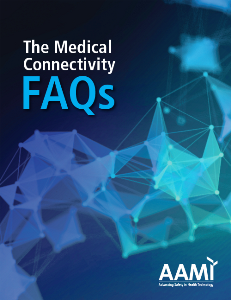Medical Connectivity FAQs
Welcome to the Medical Connectivity FAQs. This document is intended to help healthcare technology management (HTM), information technology (IT), and facilities management professionals understand the state of wireless tools and technologies, their use in healthcare, and how they can best be managed given the disparate roles and responsibilities. We hope this compilation of FAQs leads to enhanced cooperation through information sharing about tools and techniques, problem solving strategies, and understanding what the differences are between these critical roles in healthcare.
We give firm answers to purely informational questions. However, for guidance questions, there is no one right or wrong answer. The goal is to provide information and pointers for the reader to make an informed decision.
TABLE OF CONTENTS -
- 1. Wireless support has been added to my responsibilities, and I don't know anything about it. Where can I go to learn?
- 2. What wireless systems and technologies are typically found in a hospital?
- 3. Are personal wireless devices (e.g., phones, iPads, etc.) in a hospital a problem?
- 4. What are the biggest mistakes that healthcare delivery organizations (HDOs) make in managing wireless issues?
- 5. Is there a glossary of terms that would help me understand all the acronyms people throw around?
- 6. I’m a healthcare technology management professional. Why should I care about wireless when it’s not in my job description?
- 7. Why are there so many contradictions in best practices from different MDMs?
- 8. What skills and tools do my team need to support a Wi-Fi network?
- 9. What are the differences between WMTS and Wi-Fi?
- 10. What are MedRadio, MBAN, and MICS, and how are they related? Are there coexistence problems with Wi-Fi or WMTS?
- 11. Is there an issue with Bluetooth and Wi-Fi coexistence?
- 12. Does it work to have two different manufacturers' Wi-Fi networks operating in the same space? What are the key considerations?
- 13. Is telemetry for patient monitoring considered wireless?
- 14. What should I look for in a medical device and the company that supplies it in terms of wireless capabilities, expertise, and support?
- 15. What wireless specifications should I be writing into my RFPs for medical devices?
- 16. How can I engage my C-suite and encourage them to invest in the wireless infrastructure?
- 17. Where does a medical device vendor’s responsibility end and my responsibility begin for managing the wireless infrastructure, network, and wireless devices?
- 18. What is IEC 80001-1?
- 19. What is risk management in the context of wireless networks and how do you perform it? What are the essential elements of it?
- 20. How expensive is it to comply with 80001?
- 21. What do the FDA’s guidance documents on cybersecurity, mobile devices, and use of wireless technologies mean for my organization?
- 22. What tools do I need to check my wireless network?
- 23. How do I know if my devices/wireless network are experiencing a high rate of interference? How can I troubleshoot it?
- 24. Do I have enough capacity for all our wireless initiatives?
- 25. Which team should own the wireless network and/or manage spectrum use?
- 26. What factors should I consider before upgrading my network software?
- 27. How do I determine the performance of medical devices on my wireless environment?
- 28. What is a wireless LAN site survey and how often should I do one?
- 29. How does cybersecurity affect the choice of medical devices?
- 30. How do I deal with legacy medical devices with obsolete security features?
- 31. What is a medical device security program and why is implementing one a worthwhile endeavor?
- 32. What is a key to starting a successful medical device security program?
- 33. What are the top priorities for a new medical device security program?
- 34. What are the top things to be concerned about when assessing a new medical device?
- 35. Where should a medical device security program reside: HTM/clinical engineering or IT/IS security?
- 36. What are some materials our organization should look at to help get started on building a medical device security program?
- 37. What’s the difference between encryption and authentication?
- 38. Are there any security risks if I broadcast my service set identifier (SSID)? Is there any reason to hide SSIDs?
- 39. What security-related information should an MDM provide to an HDO?
- 42. Are there wireless devices for which a communication failure can interrupt patient care?
- 43. What are the hazards for a wireless medical device and for a clinical wireless network? Where can I go to learn about risk mitigation strategies?
- 44. What are some of the common hazards encountered on the 802.11 wireless network?
- 45. How is a network design documented and how is the current status of the network viewed?
- 46. What is a distributed antenna system (DAS) and what are the pros and cons?
- 47. What is bandwidth? Why is bandwidth important in wireless communication such as 802.11 (Wi-Fi), Bluetooth, WMTS, and cellular?
- 48. How do I ensure that my wireless network remains reliable?
- 49. Should I let the wireless controller dynamically set the power on my APs? That is, should I allow ARM (Aruba) or RRM (Cisco) to change the power levels? Will a statically assigned power setting of 100 milliwatts (mW) result in better coverage?
- 50. Should I assign the channels on my APs?
- 51. What is the best method for setting up 802.11 APs to provide strong signal coverage and optimum performance in a “greenfield” installation?
- 52. Will AP power settings work the same for all wireless devices supported at the same location?
- 53. Which 802.11 standards will I most likely encounter in my environment? What are some of the more important amendments?
- 54. What are the reasons to maintain or stop support for 802.11b?
- 55. What is the difference between WPA2-PSK and WPA2-Enterprise?
- 56. Why are WEP and WPA-PSK/TKIP no longer considered secure? What kind of wireless encryption should HDOs be using? How will this impact organizational support for wireless medical devices?
- 57. What are the advantages of 802.11ac Wave2 over 802.11a/b/g/n? Are there any disadvantages besides the cost of replacing my wireless APs?
- 58. Should I turn off lower 802.11b data rates to get better performance on my 802.11b/g network?
- 59. What are Dynamic Frequency Selection (DFS) channels and what are the pros and cons of using them?
- 60. What is wireless medical telemetry?
- 61. What is the Wireless Medical Telemetry Service (WMTS)?
- 62. Why was the WMTS created?
- 62. What does licensed spectrum mean?
- 64. Does medical telemetry operating in the 608-614 MHz band experience interference now?
- 65. What is the FCC 600 MHz incentive auction?
- 66. How did the FCC incentive auction impact devices operating in the WMTS and does it impact the 1.4 GHz WMTS bands?
- 67. How can hospitals respond to interference?
- 68. Why doesn’t the FCC reallocate the 2.4 GHz band for the WMTS?
- 69. What is Bluetooth wireless technology?
- 70. What are the different kinds of Bluetooth (“classic,” “low energy”) and what are their frequency characteristics?
- 71. What are the different Bluetooth revisions? (Bluetooth 1, 2, 2.1, 4.0, 5, etc.)
- 72. What Bluetooth revision should hospitals be using?
- 73. Do all cellular phones, tablets, and laptop computers work with Bluetooth?
- 74. What is Bluetooth pairing: How does it work and how has it changed with the various revisions?
- 75. How does Bluetooth coexist with 802.11?
- 76. Does our microwave oven interfere with Bluetooth?
- 77. How many Bluetooth devices can be in one room?
- 78. Can a cellular phone that supports Bluetooth connect to hospital Bluetooth devices?
- 79. Is Bluetooth audio different from Bluetooth data? Can I have a call to my headset while other Bluetooth devices are communicating?
- 80. What are some Bluetooth-specific security considerations?
- 81. What are some security concerns for using BLE for wayfinding and patient engagement?

